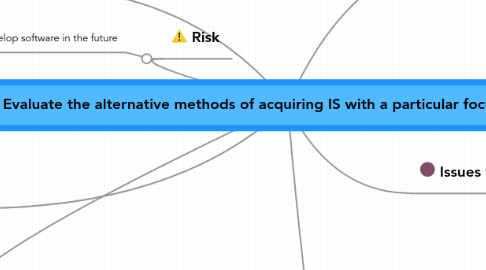
1. Risk
1.1. Proprietary software vendor may not choose to develop software in the future
2. Inhouse Development
2.1. About
2.1.1. System is developed internally
2.2. Benefits
2.2.1. Control over the direction of the development of the IS
2.3. Drawbacks
2.3.1. If a large project, new IT staff may be required
2.3.2. Systems may be available elsewhere
2.3.3. Staff may be inexperienced in developing this style of application
2.3.4. May be too technically challenging
2.4. Risk
2.4.1. Project may be too technically challenging
2.4.2. Systems may not be delivered on time
2.4.3. Project may incur unexpected costs
2.5. Similar alternatives
2.5.1. Outsourcing software
2.5.2. Using contractors
2.5.3. End User Computing
3. COTS - Commercial Off the Shelf Software
3.1. About
3.1.1. Software is proprietary
3.2. Benefits
3.2.1. IS can be acquired quickly
3.2.2. Many alternatives are available
3.3. Drawbacks
3.3.1. Limited scope to make adjustments
3.3.2. Unable to direct the direction that software develops (new features etc)
3.4. Similar Alternatives
3.4.1. Open Source Software
3.4.1.1. About
3.4.1.1.1. Applications in which the underlying code of an application is released to the IT community
3.4.1.2. Benefits
3.4.1.2.1. Source code is made available, making it easier to make changes to software
3.4.1.2.2. Less risk if the organisation goes bust- community may continue to support the software longer.
3.4.1.3. Drawbacks
3.4.1.3.1. Performance may not be as high as proprietary
3.4.1.4. Examples
3.4.1.4.1. MySQL Database
3.4.1.4.2. Mozilla Firefox
3.4.1.4.3. GIMP
3.4.1.4.4. Linux OS
3.4.1.5. Licenses
3.4.1.5.1. GPL
3.4.1.5.2. Others
3.4.1.6. Benefits
3.4.1.6.1. The Conservatives have estimated that £600million could be saved from government adopting OSS
3.5. Also consider
3.5.1. Licensing
3.5.2. Support
3.5.3. Training
4. User Developed Software
4.1. What is it
4.1.1. Employees develop software for the benefits of one user
4.2. Examples
4.2.1. Self Generated Reports from corporate databases
4.2.2. Spreadsheet Simulations of Financial Projections
4.2.3. Also known as End User Computing
4.3. Benefits
4.3.1. Cheap - no cost of experienced development staff
4.3.2. Better user satisfaction
4.4. Drawbacks
4.4.1. See risks
4.4.2. Little testing if any is carried out for software
4.5. Risks
4.5.1. Errors may be in formulas created
5. Outsourcing
5.1. What is it?
5.1.1. The use of an external organisation to develop bespoke software
5.1.2. A field of management services
5.2. About
5.2.1. IT Management contract out IT Services
5.2.1.1. May involve
5.2.1.1.1. Specific Application
5.2.1.1.2. Oursourcing whole IT department
5.2.1.1.3. Offshoring IT
5.3. Benefits
5.3.1. IT may not be seen as a core activity
5.3.2. Gain the experience of the knowledge held by the service provider
5.3.2.1. Hardware
5.3.2.2. Software
5.3.2.3. Available IT within a particular sector such as IT
5.3.3. Be able to have IT services at a lower cost that currently
5.4. Drawbacks
5.4.1. Communication channels may be longer.
5.5. Risks
5.5.1. Cost savings may not be realised
5.5.2. Company knowledge transferred outside the organisation
5.5.3. Changes to agreed contacts may be expensive.
5.6. Similar Alternatives
5.6.1. Application Service Providers
5.7. Example organisations
5.7.1. IBM Global Services, HP, Xansa, Accenture
6. Issues to take into account
6.1. IT Department
6.1.1. People
6.1.1.1. Experience in the IT department
6.1.1.2. Skills of the IT staff
6.1.1.3. Size of the IT staff
6.1.2. Is are the major concerns for IT operations?
6.1.2.1. Maintaining Systems?
6.1.2.2. Server power, space, upgrade requirements
6.2. System Requirements
6.2.1. Is the project technically challenging?
6.2.2. How urgent is the Information System required?
6.3. Cost
6.3.1. Is the IS expected to play a strategic role in the organisation?
6.3.2. Is it cheaper to develop the system outside of the country (Offshoring)?
6.4. Business
6.4.1. What is the determining factor for the organisation?
6.4.2. How soon does the organisation require the system?
6.4.3. Is the business likely to grow in the future? How does this change the system choice
6.5. Risk
6.5.1. What is the degree of risk associated with the options?
6.5.2. Which option has the least risk?
6.6. Options Available
6.6.1. How much does the IT department know about each of the options?
6.6.2. Has the department had previous experience which was positive?
6.6.3. How flexible are the options?
6.6.4. Which method is likely to most improve the efficiency / effectiveness of the organisation?
6.6.5. What are the terms of the lisencing for the application?
7. ASPs
7.1. What are they?
7.1.1. Application Service Providers
7.2. Benefits
7.2.1. No need to develop software
7.2.2. Other organisations have used and tested software
7.2.3. No need to purchase application servers, or maintain application internally
7.2.3.1. reduction in direct staff costs
7.2.3.2. reduction in power consumption
7.2.4. No direct costs including IT staff or maintainance contracts associated with maintaining systems
7.3. Drawbacks
7.3.1. Flexibility
7.3.1.1. Little customisation may be available for the application.
7.3.1.2. Unable to state how the application develops in the future
7.3.2. IT Network
7.3.2.1. Increase in load of data entering corporate network
7.3.2.2. Users can't work offline
7.3.3. May need to change business processes to fit in with software
7.3.4. May not be able to integrate software with other applications
7.4. Risk
7.4.1. Company may go under
7.4.2. Risk of others getting access to Internal data
7.4.3. Data not being backed up by the ASP
7.5. Examples
7.5.1. CRMondemand
7.5.2. Google Docs
7.5.3. SugarCRM
